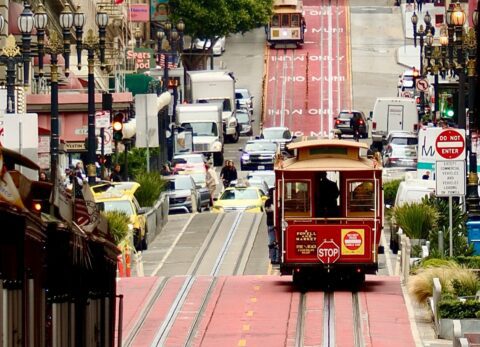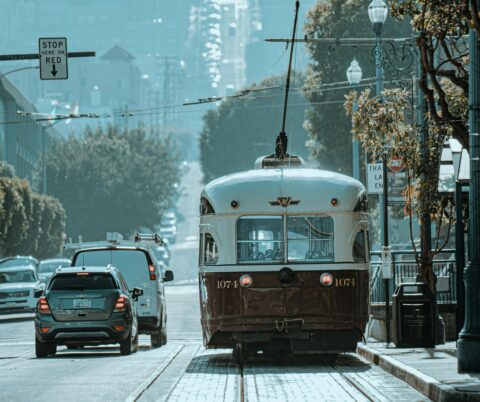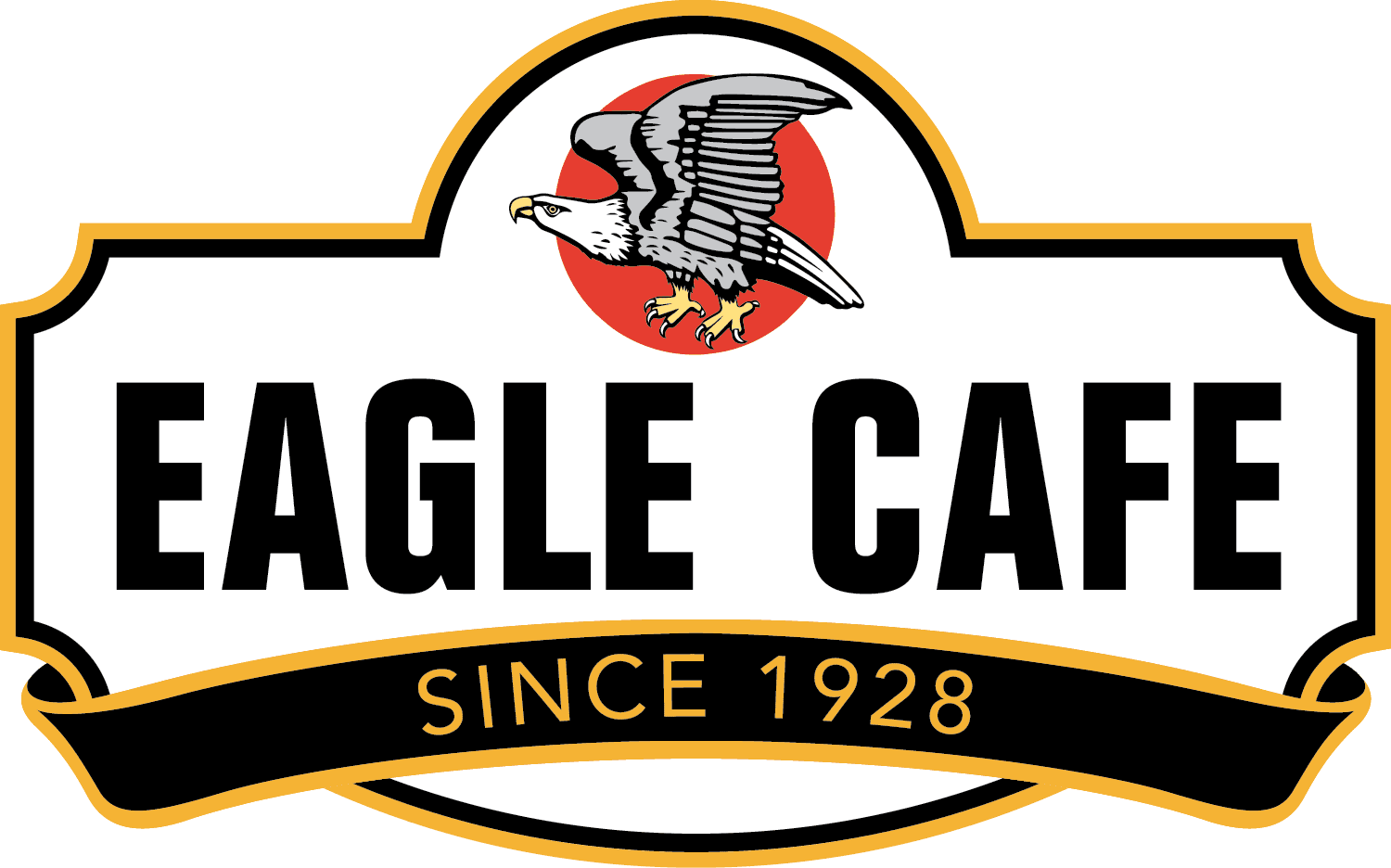
Cable Cars in San Francisco are iconic symbols of the city’s identity and innovation. These historic vehicles have been moving us around the city’s hills since the late 19th century! Let’s dive into how the San Fran cable car system came to be and why it remains so integral to San Francisco’s culture today.
While you’re in San Francisco, be sure to grab breakfast or lunch at San Francisco’s favorite Eagle Cafe, one of PIER 39 restaurants. Enjoy views of the bay, the Golden Gate Bridge, and Alcatraz Island while eating classics like Banana Pecan French Toast and the Eagle Burger. Walking distance from the last cable car stops!
History of the Cable Car in San Francisco
Did you know that the SF cable car was first invented in 1873? In 1869, inventor Andrew Smith Hallidie came up with the idea for cable autos in San Francisco after watching horses struggle to carry cars up hilly, wet cobblestone streets. A few years later, Hallidie turned his idea into reality by creating a steam engine-powered and cable driven rail system.
Who was Andrew Smith Hallidie?
Andrew Smith Hallidie was an engineer who invented the San Fran cable car. Born in London in 1836, Hallidie grew up with an interest in science and mechanics. By ten years old, he had already successfully build an “electrical machine.” At 16, his father decided to take him to California to improve his health. The journey from the U.K. to New York to Panama and finally to San Francisco took about 100 days!
He spent a few grueling years working as a miner and blacksmith, but all the while he continued to use his skills as an engineer to invent solutions to problems in the field. One of his ventures began the manufacture of wire rope in California, and he pursued this as a business under the name A. S. Hallidie & Co. He grew a reputation as a builder of suspension bridges and continued with other inventions.
Making the San Francisco Cable Car Possible
In 1867, Hallidie invented the “Hallidie Ropeway [or Tramway]” which according to the SF Museum was “a method of transporting ore and other material across mountainous districts by means of an elevated, endless traveling line.” He then saw that the cable could wear down and break, so he invented steel cable that could withstand the weight and the journey.
The Museum of the City of San Francisco shares Hallidie’s own words for his idea of the cable car in San Francisco:
I was largely induced to think over the matter from seeing the difficulty and pain the horses experienced in hauling the cars up Jackson Street, from Kearny to Stockton Street, on which street four or five horses were needed for the purpose–the driving being accompanied by the free use of the whip and voice, and occasionally by the horses falling and being dragged down the hill on their sides, by the car loaded with passengers sliding on its track…..
Hallidie combined his experience with mining and creating bridges, tramways, and steel cables to solve this problem. And thus the San Fran cable car was born! Check out the free Cable Car Museum to learn more about the heritage and see their collection of historic cable cars firsthand.
Cable Car San Fran Today
Now that you know about how cable cars in San Francisco came to be, you’re ready to ride! Fortunately, taking a cable car ride in San Francisco is easy. San Franciscans made sure that cable cars would stay accessible no matter their operation costs! Here’s what you need to know.
How to Get a Cable Car Ride in San Francisco
First, check out the San Francisco Cable Car Routes map to see all the stops you could get on and off at. Make a plan to decide where you’d like to go and what you’d like to see! Most people choose to hop on at the turnarounds and terminals marked on the map, but keep in mind that means a longer wait time.
Get on board at the stop and then pay. There will be a worker there to help you with payment. To see the most updated fares, visit the SFMTA website here. As of June 2024, a single San Francisco cable car ticket costs $8, and $4 for seniors/disabled/Medicare and free for youths 4 and under. Cash, paper tickets from cable car ticket booths, MuniMobile app, and Clipper Card all work! We recommend the all-inclusive 1-, 3-, or 7-Day Visitor Passport for tourists, which includes SFO cable car day pass.
When you’re ready to get off the cable car, tell the grip worker “Next stop, please!” at least half a block before the stop. They do not stop at every single stop, but only when there are requests to stop. Keep your eyes on the street signs to be certain you’re getting off at the right stop.

Streetcars vs Cable Cars – What’s the Difference?
It’s easy to get confused between streetcars and cable cars in San Francisco! Both are historic trolleys/trams that are still in operation today.
Streetcars, like cable cars, run on steel rails. The difference is that street cars do not also use underground cables and instead a propelled by electric motors. They draw their power from trolley poles connected to overhead wires.
Market Street Railway shares a simple test to be able to tell the difference between streetcars and cable cars sfo:
If it runs on steel rails with a trolley pole connected to an overhead wire above, it’s a streetcar.
If it runs on steel rails with an open slot between them, and no overhead wires, it’s a cable car.
Not to be confused with trolley coaches, which are buses connected to a pair of overhead wires! Those have rubber tires and are easier to spot.

Eagle Cafe – Walking Distance from the Cable Cars
Take the Powell-Hyde line or the Powell-Mason line cable cars to their final stop near Fisherman’s Wharf, and you’ll be walking distance to one of San Francisco’s best breakfast and lunch spots Eagle Cafe! From the end of the California Line, hop on to the Embarcadero street car which will take you directly to PIER 39.
Eagle Cafe has been around since 1928. In other words, this cafe is an expert at all things San Francisco, breakfast, and lunch! If you’re looking for classic San Francisco foods, look no further than Eagle Cafe. This special eatery is also unique for its incredible views of the bay, the Golden Gate Bridge, and Alcatraz Island. After your meal, venture to the PIER 39 K-Dock to witness California’s sea lions up close!
Walk-ins Welcome!
